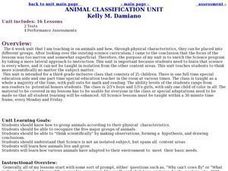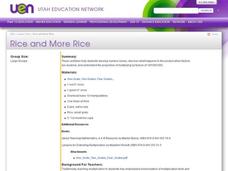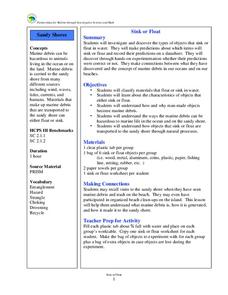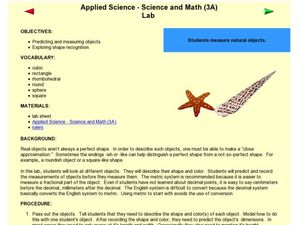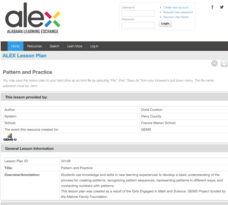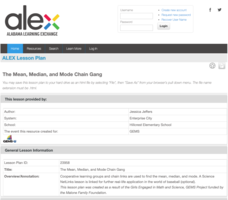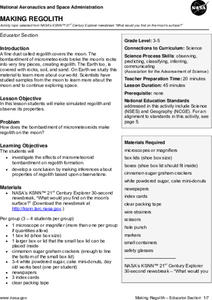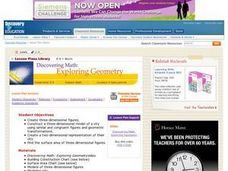Curated OER
Representing Relationships with Equations
Young scholars explore Cuisenaire Rods. In this pre-algebra lesson plan, students work with a partner to generate addition problems with the sum of ten using Cuisenaire Rods. Young scholars construct examples of the Commutative...
Curated OER
Design a Track
Pupils investigate track and field dimensions, measure an actual track, and construct a scale model. The use of a meter stick, dimensional analysis, and the application of the distributive property to variables forms the main focus of...
Curated OER
Area, Arithmetic and Algebra
Students model formulas for rectangles and squares. In this area, arithmetic and algebra lesson plan, students explore the formula for the area of squares and rectangles. They use squares to model the formula for the area and identify...
Curated OER
Animal Classification Unit
Third graders study how to group animals by their physical characteristics. They examine how animals have adapted to have their needs met by the environment.
Curated OER
Rice and More Rice
Fifth graders explore problem solving strategies for mathematical estimation. In this math problem solving lesson, 5th graders predict how many grains of rice are in a jar, practice establishing and looking for patterns in...
Curated OER
Extra Practice 6: Using the Distributive Laws and Factoring
In this practice worksheet, students solve multiplication equations by using the distributive property, factoring, and the integer rules. They solve 32 problems on this one-page worksheet.
Curated OER
Slippery, Slippery Ice
Students investigate how salt affects ice by experimenting in class. In this water properties lesson, students utilize a penny, salt and pans of ice to examine the sliding ability of a penny across a layer of ice. Students...
Curated OER
Chemical Changes
Learners compare types of chemical change. In this chemical reaction lesson, students use a variety of household items to investigate different types of chemical change. Learners will engage in a discussion about the dangers of chemicals...
Curated OER
Sink or Float
Learners explore water properties by conducting a class experiment. In this buoyancy lesson, students make predictions as to whether or not specific objects will sink or float in water. Learners conduct the experiment and record their...
Curated OER
Laws of Exponents
Ninth graders identify the different laws of exponents. In this algebra lesson, 9th graders write the rules of exponents and use them to solve problems. They use the product, quotient laws to solve problems.
Curated OER
Describing Nests
Students observe bird nests. In this observation level, students explore bird nests using their five senses. Students compare and contrast bird nests while hypothesizing about the need birds have to construct the nest.
Curated OER
Measuring Natural Objects
Students predict the measurement of objects. In this measurement lesson, students estimate the measurements of objects in a lab. Students measure irregular objects and generate scientific observations.
Curated OER
Quadrilateral Explorations-Grade Nine
Ninth graders investigate quadrilaterals. In this geometry lesson, 9th graders examine and classify quadrilaterals using the slope, midpoint and distance formulas. Additionally, students create various quadrilaterals given...
Alabama Learning Exchange
Pattern and Practice
Young scholars learn how to make patterns. Students first display their prior knowledge of patterns before delving into the lesson. They complete a worksheet and participate in a web-based class activity. They work in cooperative groups...
Curated OER
Spherical Geometry: A Global Perspective
Students investigate spherical geometry using a globe and an apple. In this spherical geometry lesson plan, students translate Euclidean geometry terms to spherical geometry terms using a globe. They answer 3 questions about spherical...
Curated OER
Preparation and Transition to Two-Column Proofs
Young scholars investigate proofs used to solve geometric problems. In this geometry lesson, students read about the history behind early geometry and learn how to write proofs correctly using two columns. The define terminology valuable...
Curated OER
Beads, Balls, and Beakers
Learners analyze the amount of space required to pack round objects. In this geometry activity, students practice using space economically by practicing packing spheres into beakers. They then translate this concept to molecules being...
Curated OER
Spill the Beans
Students explore the meaning of a fact family. In this Math lesson, students work in small groups to create their own fact family based on color of beans. The beans are colored and represent a given value. Students discover the...
Alabama Learning Exchange
The Mean, Median, and Mode Chain Gang
Students analyze a set of data. They work in cooperative groups and use chain links to identify the mean, median, and mode of the chain.
Curated OER
What's My Rule for Sorting?
Students view objects sorted by one characteristic and name that characteristic. In this sorting rule lesson, students explore to find a new characteristic and write a description of that rule. In early grades the rule might...
Curated OER
The Apprentice: A Study of Business and Technical Writing
Middle schoolers explore business practices by creating a portfolio in class. In this business writing lesson, students identify the causes for a businesses success and failure before deciding on a business they would like to create....
Curated OER
Multiplying Polynomials
Students explore the concept of multiplying polynomials. In this multiplying polynomials instructional activity, students watch a video clip about basic math skills. Students work in groups on an exploration about why a binomial squared...
Curated OER
Making Regolith
You may not be able to take a field trip to the moon, but that doesn't mean your class can't study moon rocks. Using graham crackers as the moon's bedrock and powdered donuts as micrometeorites, young scientists simulate...
Discovery Education
Exploring Geometry
Middle schoolers construct a three-dimensional model of a city using both similar and congruent figures and geometric transformations. City must have at least ten buildings with each building labeled and may be constructed out of paper...





